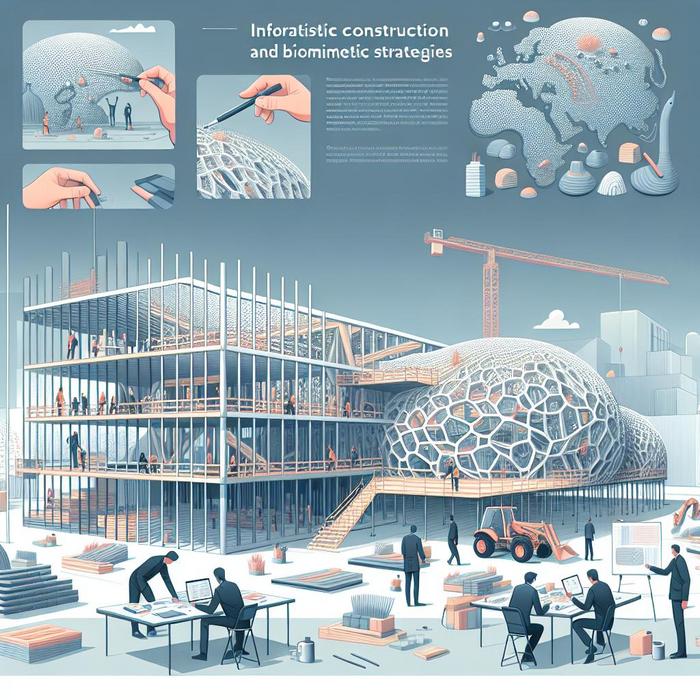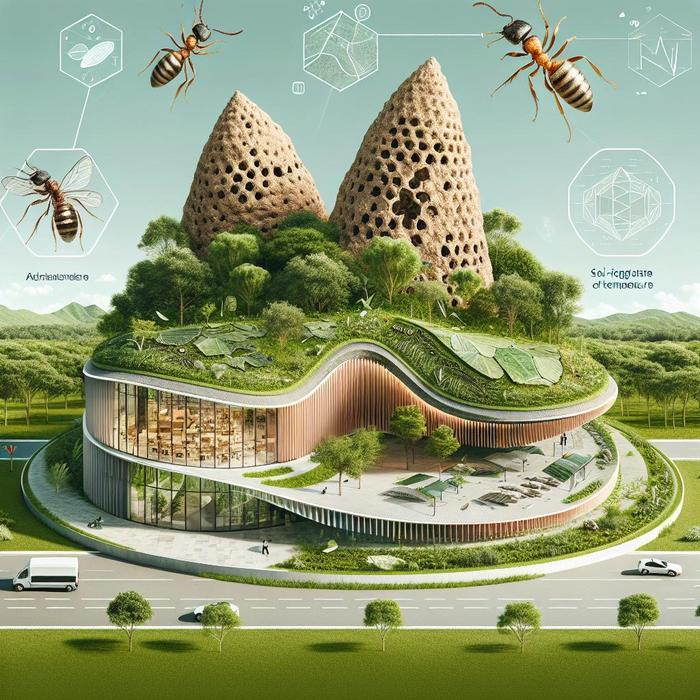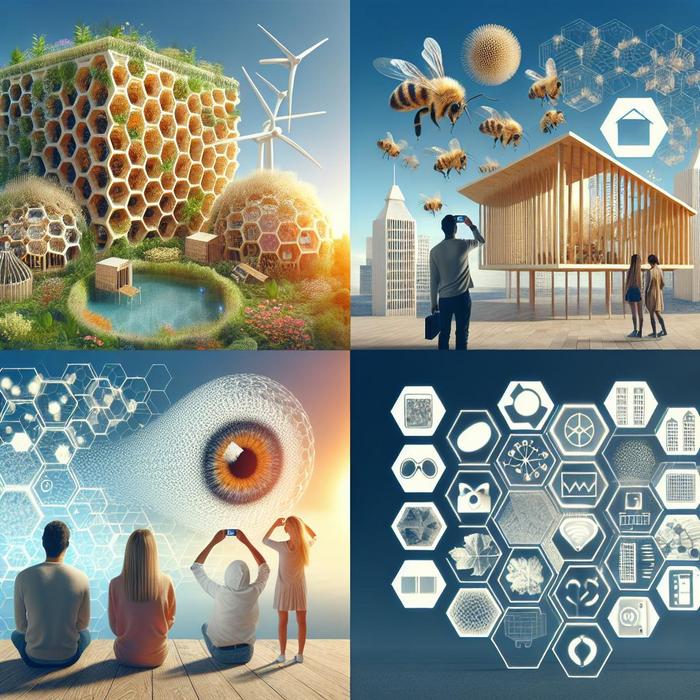Is it possible to harmonize construction methods with Mother Nature’s tactics?
Indeed, the answer is a resounding “yes!” And the secret lies in leveraging the power of biomimicry engineering or biomimeting. The wonders of biomimicry engineering are becoming progressively popular in the construction industry, with numerous revolutionizing and sustainable outcomes. It’s a discipline that probes deep into the heart of nature to unravel the secrets of efficient and sustainable structures and processes.
Why turn to biomimicry for construction satisfaction?
The beauty and strength of biomimicry or biomimeting emanate from the simple yet profound fact that nature, through millions of years of evolution, has polished its designs to achieve the ultimate in efficiency, resilience, and sustainability. Therefore, by mimicking these natural processes in construction, we tap into age-old wisdom that enhances building efficiency while lowering environmental impact. For instance, the concept of self-healing materials, influenced by the healing process in nature, can help in creating structures that repair themselves after damage like this.
Tangible Biomimetic Strategies in Construction
• Energy Efficiency: Termite mounds are perfect examples of passive cooling systems, inspiring energy efficient building designs. They maintain a constant internal temperature despite the external temperature swings, enabling remarkable energy savings in the long run.
• Resistance and Flexibility: Bamboo serves as a classic example of a natural material possessing extraordinary resistance and flexibility. Its unique structure provides seismic resistance, inspiring the development of bamboo-mimicking construction materials.
• Self-cleaning Surfaces: Lotuses exhibit an exceptional self-cleaning mechanism, inspiring building surfaces that repel dust, thereby reducing maintenance costs and effort.
Revolutionizing Urban Spaces via Biomimicry
Biomimicry offers a fresh perspective to reimagine urban spaces. By emulating natural processes and systems, we can create urban spaces that are harmonious with natural ecosystems and promote human well-being. A shift from traditional construction techniques to biomimetic strategies like this can facilitate a drastic transition towards sustainable urban development.
The Pathway Forward with Biomimicry
Biomimetic principles and design cues from nature offer a roadmap to the future of sustainable construction. They are not just about constructing buildings but about building ecosystems that will stand the test of time. It leads to the development of construction solutions that are not only practical and efficient, but also self-sustaining and harmonious with nature such as these.
Building on this, integrating biomimicry into mainstream construction practices requires a commitment to learning and adapting from nature. As various stakeholders embrace this, we can witness a collective shift in perspective that will drastically redefine our relationship with the built environment.
Transcending Construction Satisfaction with Biomimicry
We can certainly derive immense satisfaction in construction through biomimicry. It’s about creating a sustainable, balanced, and harmonious built environment that resonates with people and nature alike. In fact, deriving inspiration from nature’s tactics can lead to significant advancements in construction and a marked improvement in our quality of life like these.
As we continue to explore and appreciate the genius of nature and its myriad solutions, the frontiers of biomimicry engineering will undoubtedly extend further. It is this promising potential that makes biomimicry a key cornerstone of future construction and an indispensable catalyst of construction satisfaction.
Are You Ready to Embrace Nature’s Tactics?
In the ever-evolving landscape of construction, integrating biomimetic strategies into our practices is not just an exigency but also a journey towards achieving unparalleled satisfaction. It is a testament to the possibilities that unfold when humanity and nature collaborate judiciously.
Adopting nature’s tactics in construction proffers a sea of opportunities to explore sustainable solutions that are in harmony with our world. It is time to open our minds, extend our vision, and embrace the wisdom of nature in construction. The wonders that await are truly magnificent.
How Do We Sustainably Construct Using Nature’s Blueprint?
Can nature be our greatest mentor in achieving sustainable and efficient construction practices? Integrating biomimicry or biomimeting strategies into construction is rewarding in both an economic and environmental perspective. As we delve further into the wonders of nature, we unearth an array of sustainable methodologies having transformative potential. By mimicking nature’s way, we can create sustainable structures and simultaneously open up avenues for economic efficiency.
Exploring the Potential of Biomimicry in Construction
Nature is a treasure trove of design marvels honed over millions of years through adaptation and evolution. Adopting these could usher in a paradigm shift in the way we carry out traditional construction. From the intricate designs found in a honeycomb to the exceptional load-bearing capacity of trees, every element of nature has something to offer in the realm of construction. Isn’t it fascinating how nature, the best engineer, exploits simple principles resulting in complex and efficient systems?
The Influence of Nature in Building Innovation
Nature’s wisdom is ubiquitous, influencing diverse settings. The Eastgate Centre in Zimbabwe, a perfect example of biomimicry in architecture, draws its design inspiration from termite mounds. Mimicking the cooling mechanism employed by termites in their mounds to maintain a consistent temperature, the building sports an ingenious ventilation system that reduces energy consumption just like this.
Biological Inspiration Bridging the Design Gap
Biomimicry does not just restrict itself to mimicking the physical aspects of nature. It also draws cues from the principles and systems operating in the natural world. Birds, for instance, have been the source of inspiration for congestion-free transportation systems like this one. They can transform the practical aspects of our urban spaces, making them more efficient and sustainable.
Unleashing the Potential of Biomimicry in Urban Planning
Beyond individual buildings, biomimicry could potentially shape entire urban landscapes, bringing about a truly sustainable future. Aligning the design of urban spaces with the underlying principles of ecosystems can promote resilience and create cities that are in harmony with nature. The approach to biomimicry should be holistic, focusing not just on individual structures, but on the wider urban form and the relationships among its elements.
Nature as a Paradigm for Sustainable Architecture
Biomimicry in architecture is a transformative strategy for sustainable construction methods. It pivots on the core values of sustainability, offering solutions that are efficient and scalable, while reducing the environmental impact. This unique alignment with nature’s principles opens up possibilities for a sustainable future like this.
Embracing Biomimetic Innovations for an Eco-friendly Future
Ultimately, the goal is to develop construction methods that are not only practical but also scalable. If the construction industry truly embraces biomimicry, the rewards are apparent. It could pave the way for a more sustainable future in which our urban spaces co-exist harmoniously with nature. Are you prepared to unlock the full potential of biomimicry and transform your construction practices?
Biomimicry: The Silver Bullet for Zero-Carbon Construction?
Can biomimicry help achieve a zero-carbon construction industry? By integrating biomimetic strategies, we can reduce energy consumption and carbon emissions considerably. Buildings designed using biomimicry principles tend to be energy efficient, resulting in reduced carbon footprint like these studies suggest.
Biomimicry: A Novel Course for Disaster-Resilient Infrastructure
Disaster-resilience is integral to any structure. Many forms in nature illustrate how they adapt and survive harsh conditions and natural disasters all through evolution and adaptation. Harnessing this wisdom can lead to the design of structures that are resilient in the face of natural disasters. Fundamental shift encouraged biomimetically, can lead to construction practices that can withstand even the most severe natural disasters.
Biomimicry: A Ride Towards Environment Compliant Transportation Solutions
Our road to sustainable and congestion-free mass transportation can also be addressed through biomimicry. By mirroring nature’s traffic-free mobility patterns, we can create transportation solutions that are efficient, viable, and compatible with the environment as exemplified here..
Biomimicry: A Staple in The Future of Construction
Biomimicry in construction is more than a novel trend or innovation; it’s a chorus for the future of our built environment. It is a valuable tool that can provide sustainable solutions in harmony with the natural world. So, are you eager to blend construction methods with nature’s strategies?
The Future Highway with Biomimicry
Biomimicry could pave the way for a better future in every area of our lives, changing our perceptions and interactions with our built environment. Following biomimicry’s philosophical thrusts, reimagining construction techniques is perhaps the first step on a long road to a sustainable future where humanity and nature intersect in unforeseen ways. Undoubtedly, these changes are already dawning, and the future looks bright.
A Paradigm Shift Towards Biomimicry Engineering
Biomimicry engineering is not a fleeting trend, but an essential shift towards sustainable and economically viable construction practices. It marks a transition to a creative epoch where nature is not just admired for its beauty, but recognized for its wisdom. In essence, it pioneers a future where our structures and built environments reflect nature’s profound wisdom such as this organization promotes.
The brilliance of biomimicry is that it doesn’t just retrofit existing technology with nature-inspired findings, but it starts fresh with a completely new design standard inspired by the age-old wisdom of nature. The journey towards a future where nature and architectural designs exist in harmony is a long one, but certainly one that is worth embarking upon. Therefore, isn’t it time for us all to embrace the natural world’s intelligence as a blueprint for design and construction?


